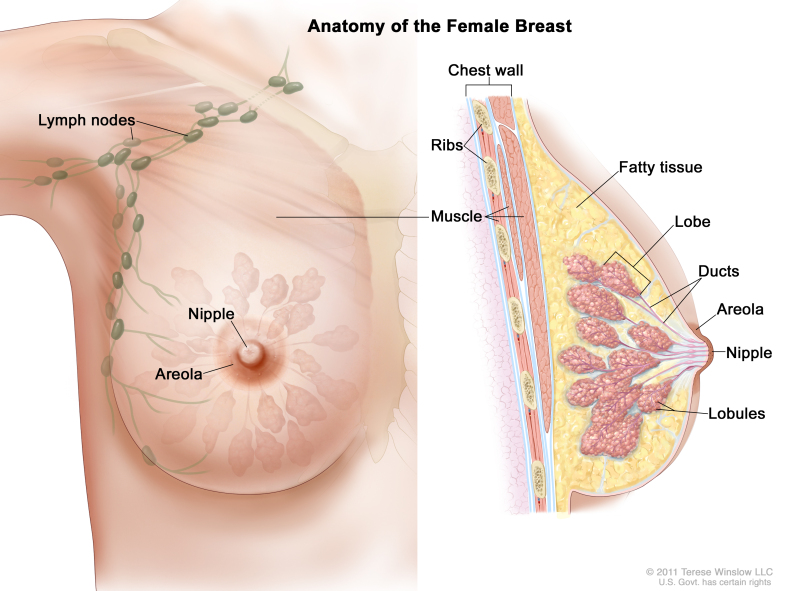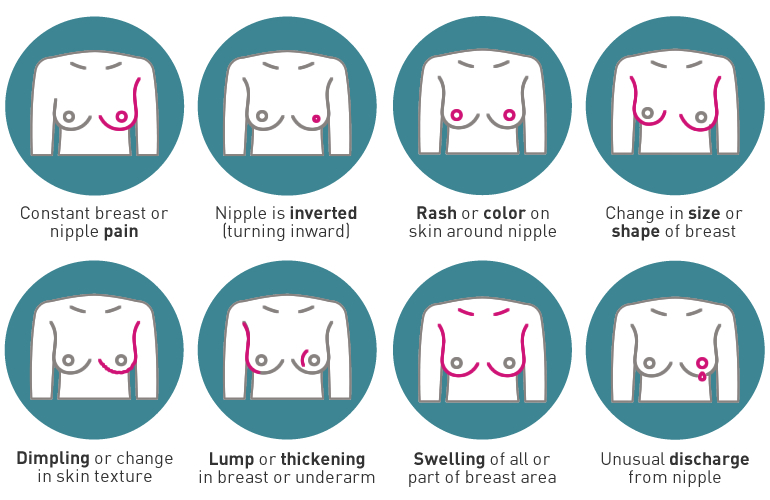What are the first signs of breast cancer?
Published Sep 9, 2021 • By Candice Salomé
Breast cancer is the most common cancer in women. In fact, nearly one in eight women will develop cancer during her lifetime. In 2021, the American Cancer Society estimates that around 330,000 new cases of breast cancer will be diagnosed. Despite these numbers, the earlier breast cancer is detected, the higher the chances of recovery.
So, what are the first signs of breast cancer? How can it be detected early? What are the risk factors for breast cancer?
We explain it all in our article!

Breast cancer is the most common type of cancer in the world and one of the leading causes of death in women. While breast cancer is still responsible for around 43,600 deaths each year, death rates are in decline. In fact, the overall death rate from breast cancer decreased by 1% per year from 2013 to 2018. This decrease is due to better screening, but also to the development of new and more effective therapies.
Currently, nine in ten (90%) women survive breast cancer for five years or more.
What is breast cancer?
Each breast contains a mammary gland consisting of 15 to 20 compartments separated by fatty tissue.
Each of these compartments consists of "lobes" and "ducts". The role of the lobes is to produce milk during breastfeeding, while the ducts transport the milk to the nipple.
The mammary gland is surrounded by supporting tissue consisting of fibers, fat and blood and lymph vessels.
 Source: PDQ Cancer Information Summaries, National Cancer Institute
Source: PDQ Cancer Information Summaries, National Cancer Institute
In 95% of cases, breast cancer cases are adenocarcinomas and most often develop from the cells of the ducts, which is then called ductal carcinoma. More rarely, the cancer can develop from the cells of the lobes, in which case is called lobular cancer.
Other types of breast cancer exist but are much rarer. Depending on the stage of development, there are two other types of breast cancer:
- Non-invasive (or in situ) breast cancer, where the cancer cells are confined to the ducts and lobes
- Invasive breast cancer, where cancer cells invade the breast tissue and can spread and affect neighboring tissues. These cells can also spread to other parts of the body to form metastasis.
What are the early signs and symptoms of breast cancer?
The symptoms of breast cancer are varied and can sometimes be completely absent. Regular screening is necessary.
Any abnormalities in the breast, however, should be promptly reported to a doctor.
In the early stages of development, breast tumors cause few symptoms, but as the breast cancer develops, its symptoms become more apparent.
The signs that should alert you are as follows:
- Appearance of a lump in the breast: This lump, which is usually not painful, is typically hard and has irregular contours. It also appears to be "fixed" in place the breast.
- Appearance of a lump in the armpit: One or more hard lumps in the armpit sometimes mean that breast cancer has spread to the axillary nodes. However, these nodes remain painless.
- Deformation of the breast
- Change in the texture or pigmentation of the skin of the breast or areola,
- Abnormal discharge from the nipple.
 Source: Young Survival Coalition
Source: Young Survival Coalition
If the cancer is not diagnosed at the first sign of symptoms, the tumor may grow and spread to other parts of the body, causing other late-term symptoms, such as:
- Bone pain,
- Nausea, loss of appetite, weight loss and jaundice
- Shortness of breath, coughing and fluid accumulation around the lungs (pleural effusion)
- Headaches, double vision and muscle weakness.
If you are in doubt, it is recommended that you consult your doctor or gynecologist. These symptoms may be benign, but only a health professional can tell, usually from the results of further tests.
How is breast cancer detected?
Several actions should be taken to encourage early detection of breast cancer. Indeed, the earlier breast cancer is detected, the easier it can be treated and the fewer after-effects of certain treatments.
In fact, from the age of 25, a clinical examination of the breasts, by palpitation, by a health professional is recommended.
Between the ages of 50 and 74, without symptoms or risk factors other than age, the CDC and the United States Preventative Services Task Force (USPSTF) recommend breast cancer screening with mammogram every two years, supplemented, if necessary, by an ultrasound, is recommended.
In case of risk factors such as:
- A personal history of invasive breast cancer or ductal carcinoma in situ, it is recommended that a clinical examination be performed every 6 months for 2 years after completion of treatment and then annually.
- A history of atypical ductal hyperplasia, atypical lobular hyperplasia or lobular carcinoma in situ, it is recommended that a mammogram be performed annually for 10 years, possibly in combination with a breast ultrasound depending on the mammogram result.
- A history of thoracic radiation therapy (high-dose medical thoracic irradiation for Hodgkin lymphoma), it is recommended that a clinical examination and an MRI be performed every year for 8 years after the end of the irradiation. In addition, an annual mammogram and a possible ultrasound scan are recommended. This follow-up is recommended without a time limit.
- A family history of breast cancer with no identified genetic mutation in the family, it is up to the medical professional to assess the woman's personal risk of breast cancer, in view of her family tree and age. The risk may then be considered high or very high. However, if a genetic mutation is identified in the family but not found in the woman, no specific screening is recommended.
Was this article helpful to you?
Give it a like and share your thoughts and questions with the community in the comments below!
Take care!
Sources:
- How Common Is Breast Cancer?, American Cancer Society
- PDQ Adult Treatment Editorial Board. Breast Cancer Treatment (Adult) (PDQ®): Patient Version. 2021 Apr 8. In: PDQ Cancer Information Summaries [Internet]. Bethesda (MD): National Cancer Institute (US); 2002-. Available from: https://www.ncbi.nlm.nih.gov/books/NBK65969/
- Signs & Symptoms of Breast Cancer, Young Survival Coalition
- What Is Breast Cancer Screening?, CDC
- Les symptômes et l’évolution du cancer du sein, Vidal
- Le cancer du sein, quels signes et symptômes ?, Le Figaro Santé
- Le cancer du sein en chiffres, Fondation pour la Recherche Médicale
- Symptômes du cancer du sein, Institut National du Cancer
- Dépistage du cancer du sein, Institut National du Cancer
- Cancer du sein : quel dépistage selon vos facteurs de risque ?, HAS

 Facebook
Facebook Twitter
Twitter


